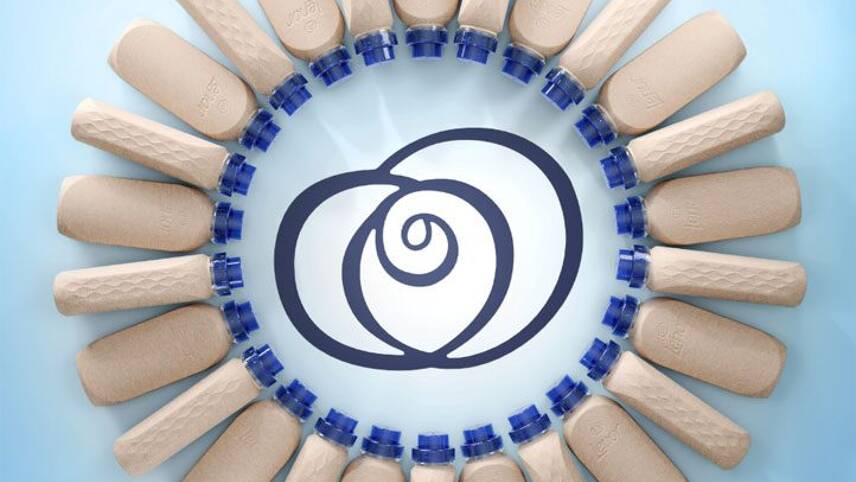Register for free and continue reading
Join our growing army of changemakers and get unlimited access to our premium content

Image: P&G/ Paboco
Paboco officially launched in October 2019 as the result of a collaboration between renewable material company BillerudKorsnäs and plastic bottle manufacturing specialist Alpla. Its ‘paper bottle community’ of businesses includes big names such as The Coca-Cola Company, Carlsberg, L’Oreal and The Absolut Company as well as new member P&G.
Speaking exclusively to edie, P&G’s senior vice-president of R&D for the global fabric and home care division, Jerry Porter, revealed that the company has been working behind the scenes with Paboco for around 12 months. The result of this work is the company’s first prototype paper bottle for the Lenor brand, which will be fine-tuned before a pilot launch of 100,000 units in Western European markets next year.
Porter said: “We’re doing this test-and-learn to understand, across the whole value chain, what the key learnings are. 2022 is really our first step. We’re expecting to need to make adjustment but the intent is to move this across more places and products, especially as we move to more generations.”
“We want to move as fast as we can.”
Porter was unable to disclose which markets the bottles will be trialled in at this stage, or information about when, precisely, in 2022 customers can expect to see them on shelves.
However, he outlined the main challenges in switching from a plastic bottle to the Paboco format for laundry products, like Lenor fabric enhancer. The current format is the company’s first-generation design and consists of a pulp-based paper outer and an internal barrier made from 100% recycled PET. The Lenor bottles maintain a plastic cap. Overall, the result is a 30% reduction in plastic used by weight.
“For our use case… we need to be able to hold the liquid in the package for the duration of the consumer experience, end-to-end,” Porter explained. “It has to make it from plants to retailers and then to the consumers, where it needs to be stable and non-leaking for a period of time under the sink.”
This long duration of storage, coupled with the need for perfumes and other key ingredients to remain active, means the packaging format needs a “high level of stability” – particularly in the case of larger packs. Despite this challenge, Porter believes the Paboco solution is scalable and that it could be “used more proudly across P&G’s portfolio over time”. The ultimate ambition, he said, is to fine-tune the format to deliver a switch to fully plastic-free packaging for some product lines.
P&G’s overarching commitments on plastic packaging include halving the use of virgin plastics by 2030, across all product categories. The Fabric Care Europe division has an interim ambition to reduce plastic use – including virgin and recycled – by 30% by 2025. The Home Care Europe Division is also going one step further and targeting no virgin plastic use at all from 2025. Other plastic-reducing innovations piloted by the FMCG giant include refillable aluminium shampoo and conditioner bottles with flexible plastic pouch refills.
A truly sustainable solution?
As outlined, Paboco bottles are not yet a completely plastic-free solution, as they rely on the recycled PET barrier to stop the contents from damaging the outer.
Paboco’s interim chief executive Gittan Schiöld told edie that the intention is to switch to a fully bio-based format for the second generation of the packaging innovation, whereby the non-bonded PET barrier is replaced with a bonded, bio-based alternative that can be recycled along with the pulp-based paper shell.
In the meantime, she admitted, dealing with the packaging at the end-of-life stage is “not seamless”. Customers are being encouraged to remove the plastic barrier, placing the paper into their household recycling and seeking out a dedicated collection service for the plastic – at least in the UK, where most councils do not collect flexible plastics from houses.
“We are working very closely with the recyclers on how the plastic will be handled, because this isn’t part of how they work today,” Schiöld said.
Research from WRAP suggests that flexible film accounted for 290,000 tonnes of plastic packaging waste in 2019. Separate research from the Flexible Packaging Consortium revealed that some 215 billion pieces of flexible plastic packaging are placed on the UK market every year and that almost all of this material is sent to landfill or incineration.
In the absence of unified recycling collections from UK councils, many retailers have opted to begin or extend in-store recycling schemes for plastic film. Among them are the Co-op, Sainsbury’s, Aldi and Tesco.
Schiöld was also asked to clarify the lifecycle impacts of the bottles, given that many proponents of plastic packaging often point to the fact that lower lifecycle emissions can be achieved than with other packaging formats such as aluminium or glass.
She said this is “something we are looking at thoroughly and covering the whole lifecycle, from responsible forestry to raw materials and production, all the way to recycling.”
Schiöld added: “We know that with each step we take to improve our technology, we are still in the early stages and are not yet comparable to the efficient packaging systems of today. But we are looking at scenarios; we need to ensure we’re going in the right direction in terms of lifecycle impact.”
P&G’s Porter added that his team “truly believes” that Paboco bottles will be more environmentally sustainable than typical virgin plastic bottles, in all senses of the word.
On climate, P&G is working towards carbon-neutral operations by 2030. This ambition covers Scope 1 (direct) and Scope 2 (power-related) emissions, which P&G expects to halve this decade before using insetting and offsetting to address the remaining half. The company is in the process of developing 1.5C-aligned science-based climate targets that will also encompass Scope 3 (indirect) emissions.
Sarah George


Please login or Register to leave a comment.